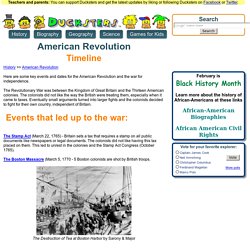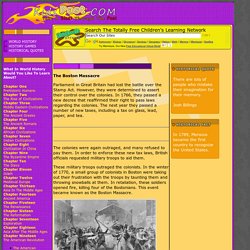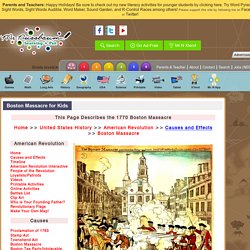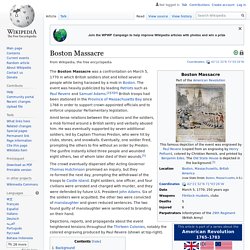

Boston Massacre Historical Society. History: American Revolutionary War Timeline. Timeline History >> American Revolution Here are some key events and dates for the American Revolution and the war for independence.

The Revolutionary War was between the Kingdom of Great Britain and the Thirteen American colonies. The colonists did not like the way the British were treating them, especially when it came to taxes. Eventually small arguments turned into larger fights and the colonists decided to fight for their own country, independent of Britain. Events that led up to the war: The Stamp Act (March 22, 1765) - Britain sets a tax that requires a stamp on all public documents like newspapers or legal documents. The Boston Massacre (March 5, 1770 - 5 Boston colonists are shot by British troops. The Destruction of Tea at Boston Harbor by Sarony & Major The Boston Tea Party (Dec. 16, 1773) - Angry with a new tax on tea, some Boston colonists calling themselves the Sons of Liberty board British ships and dump crates of tea into the Boston Harbor.
The Boston Massacre. Crispus Attucks is a name synonymous with the Boston Massacre.

He was not only the first African American to die for the revolution, he was one of the first patriots to give his life for the cause. American blood was shed on American soil. The showdown between the British and the Americans was not simply a war of words. Blood was shed over this clash of ideals. Although large-scale fighting between American minutemen and the British redcoats did not begin until 1775, the 1770 Boston Massacre gave each side a taste of what was to come. No colony was thrilled with the Townshend duties, but nowhere was there greater resentment than in Boston. The Boston Massacre. The Boston Massacre Parliament in Great Britain had lost the battle over the Stamp Act.

However, they were determined to assert their control over the colonies. In 1766, they passed a new decree that reaffirmed their right to pass laws regarding the colonies. The next year they passed a number of new taxes, including a tax on glass, lead, paper, and tea. The colonies were again outraged, and many refused to pay them.
These military troops outraged the colonists. The events of the Boston Massacre were spread quickly by newspapers throughout the colonies, further angering colonists. Boston Massacre for Kids « The situation in Boston grew more tense by the day.

Local skirmishes between townspeople and British soldiers (Redcoats) increased in frequency as did belligerence toward British soldiers. Rumors abounded throughout the city about possible attacks by soldiers or by the Sons of Liberty. On Monday night March 5, 1770, an American (patriot) began harassing a Redcoat named John Goldfinch standing guard. Another Redcoat nearby, named Hugh White, joined Goldfinch to defend him.
Boston Massacre - Wikipedia. Confrontation that occurred on March 5, 1770 Amid tense relations between the civilians and the soldiers, a mob formed around a British sentry and verbally abused him.

He was eventually supported by seven additional soldiers, led by Captain Thomas Preston, who were hit by clubs, stones, and snowballs. Eventually, one soldier fired, prompting the others to fire without an order by Preston. The gunfire instantly killed three people and wounded eight others, two of whom later died of their wounds.[5] Depictions, reports, and propaganda about the event heightened tensions throughout the Thirteen Colonies, notably the colored engraving produced by Paul Revere (shown at top-right). Background Lord Hillsborough had recently been appointed to the newly created office of Colonial Secretary, and he was alarmed by the actions of the Massachusetts House. —Excerpt from A Short Narrative, suggesting that the soldiers were contemplating violence against the colonists[13] Incident Aftermath Investigation Mr.